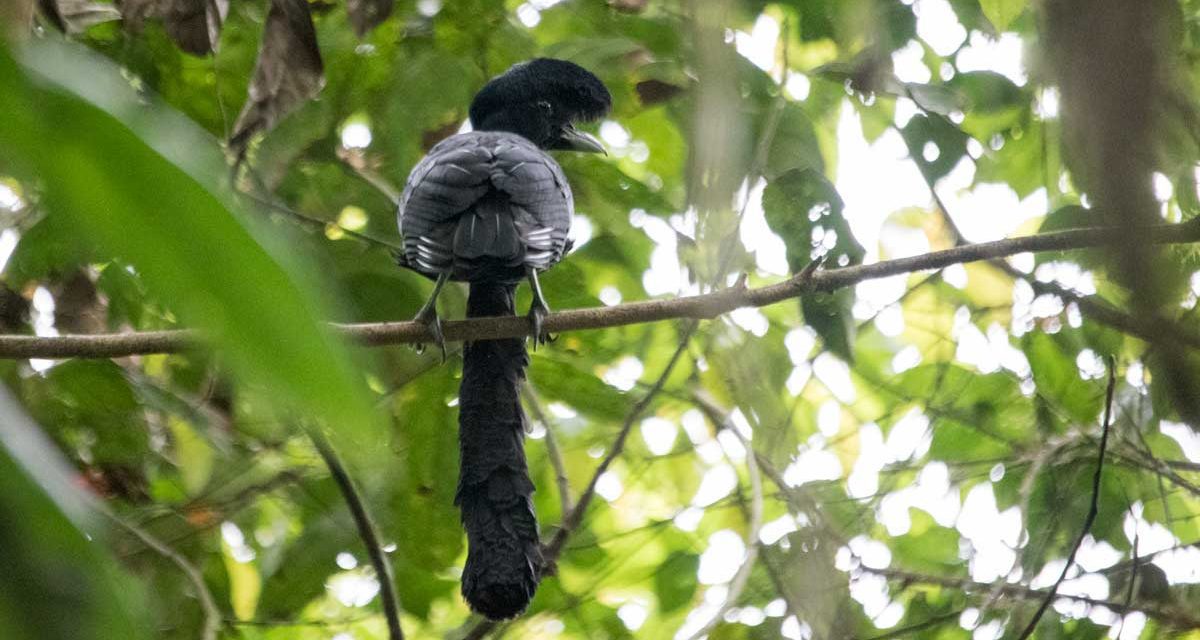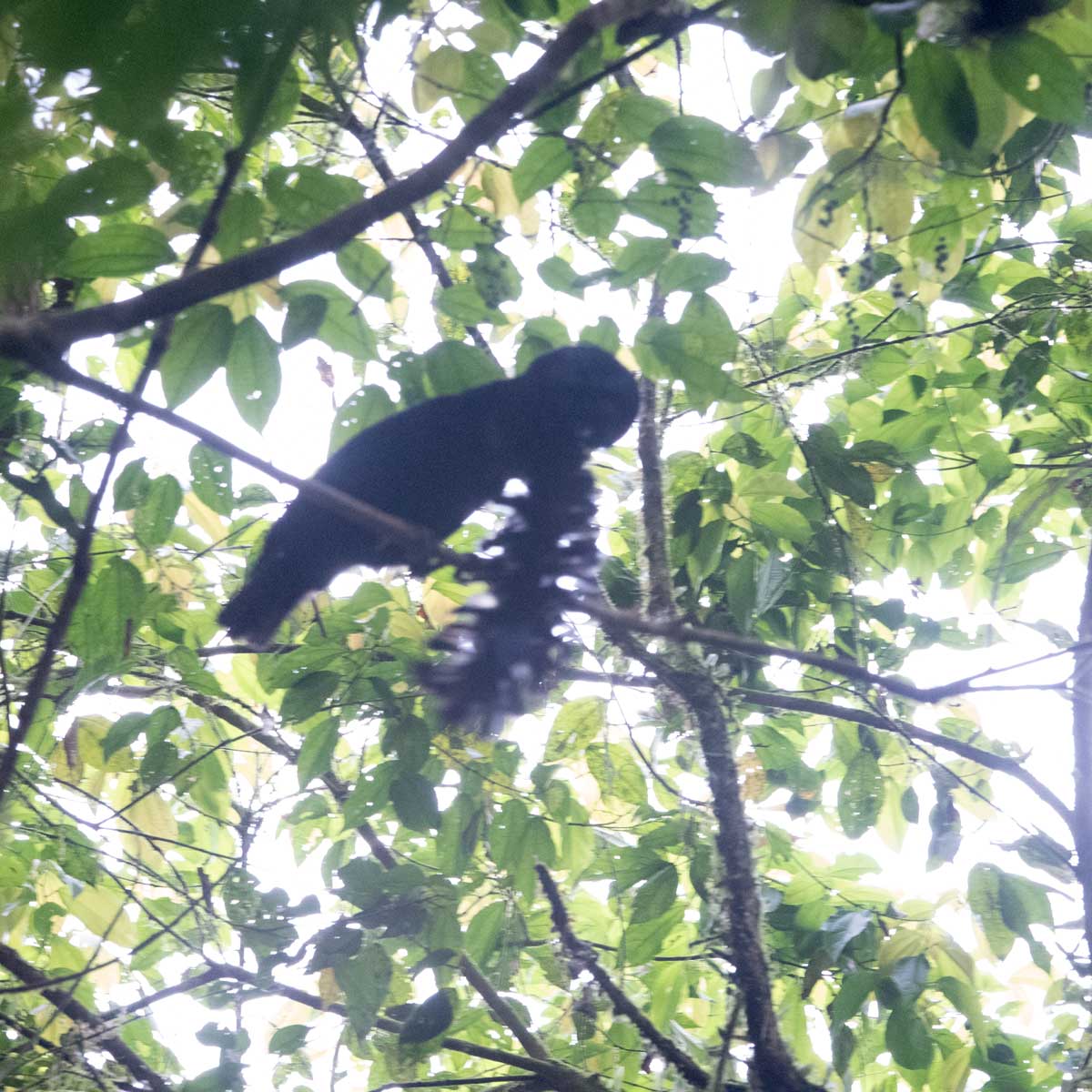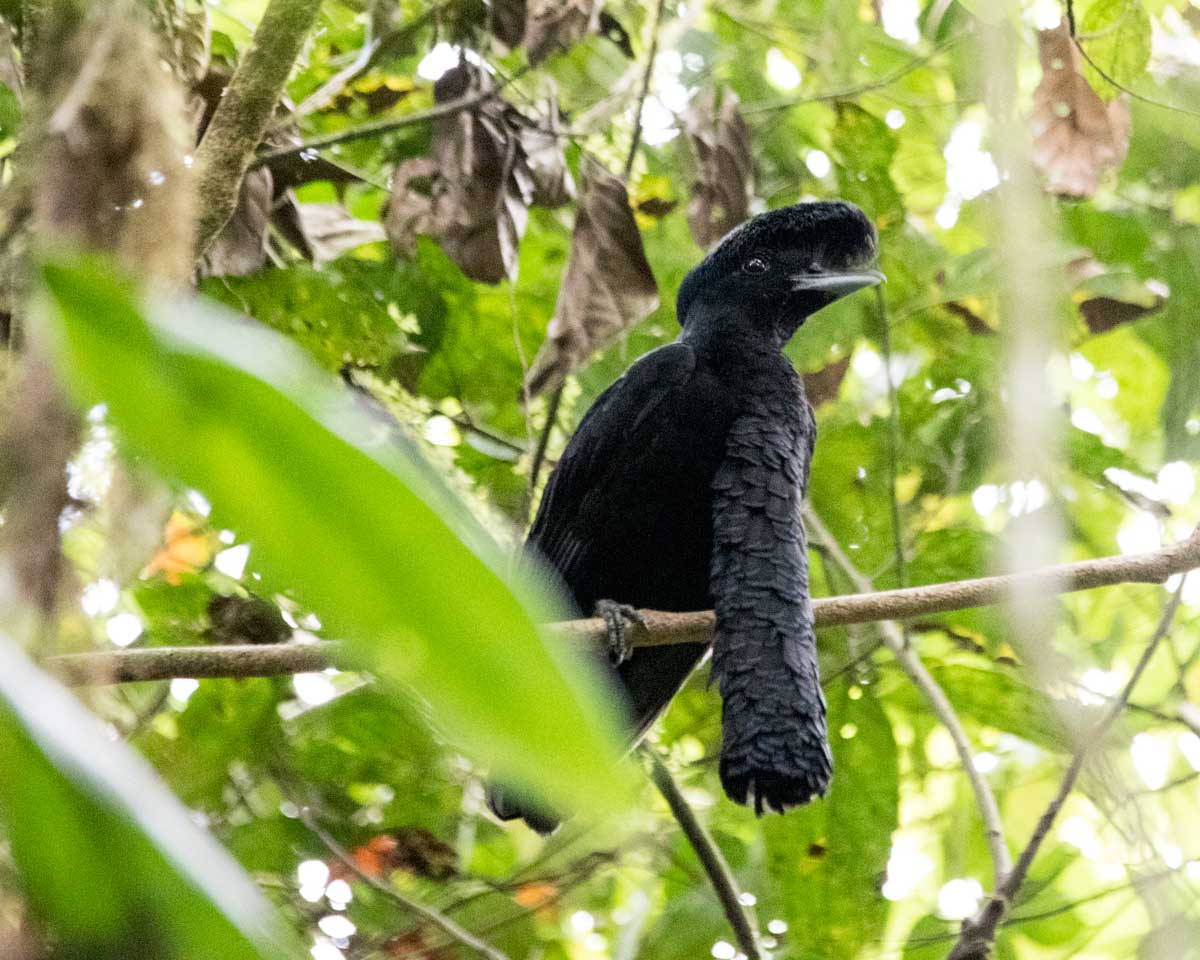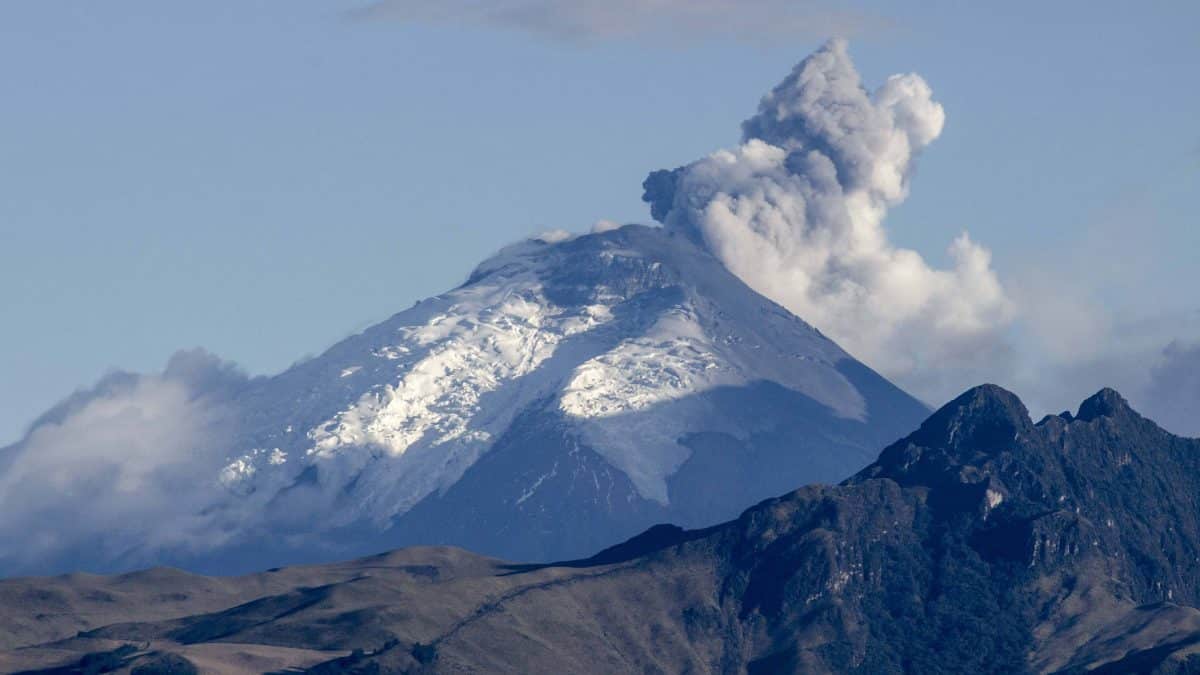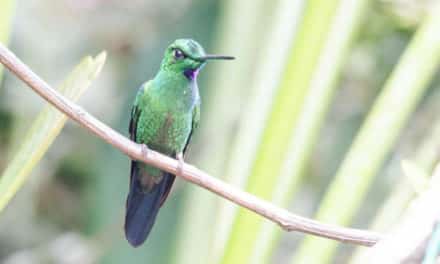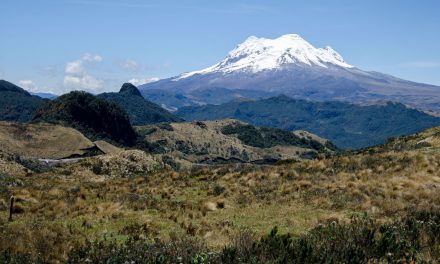As responsible travelers evolve, so do the stories we share.
This article is part of our living archive — trusted content we continue to care for.
First published on May 2, 2019 • Last updated on December 5, 2025.
When we arrived at the Umbrellabird Lodge on the Jocotoco Foundation’s Buenaventura Reserve, we were ready to do some birdwatching. Little did we know that our hunt for new birds (at least new to us) would lead to such a strange and bizarre creature, the Long-Wattled Umbrellabird.
What is an Umbrellabird?
The Umbrellabird is a member of the Cotinga family. These birds have strong legs, broad wings, and thick bills. Many have strange looking features, like the mesmerizing bobble-head on the Cock of the Rock. Others bear strange names like fruitcrows and fruiteaters. All are found in Central and South America.
Umbrellabirds are unique among the Cotinga family. There are three species, the Ornate Umbrellabird, the Long-wattled Umbrellabird, and the Bare-necked Umbrellabird. The Ornate Umbrellabird, sometimes called the Amazonian Umbrellabird, lives in the Amazon Basin and in a small area along Ecuador’s Andean East Slope. The Bare-necked Umbrellabird, found in Panama and Costa Rica, stands out for its bright red wattle. Otherwise, these birds are all black with a slight sheen of blue or green in bright light.
Today, I am writing primarily about the third species, the Long-wattled Umbrellabird. Found in the Choco-Andino Region of Ecuador and Colombia, this endangered species can be very hard to see. Fortunately, there is a known lek (more on that below) near the Umbrellabird Lodge!
History of the Umbrellabird
Not a lot is known about the mysterious Umbrellabird family. We do know that Alfred Russel Wallace, a naturalist and contemporary of Charles Darwin, recorded one of the first sightings by a European while on an expedition to the Amazon. In 1850, he sent a report to the Zoological Society of London with a perfect description of this strange and bizarre bird:
The Umbrella Bird is about the size of a crow, averaging about 18 inches in length. Its colour is entirely black, but varied with metallic blue tints on the outer margin of the feathers. The colour of the iris is greyish white. It is a powerful bird, the bill being very large and strong, the feet short, and the claws acute.
Were it not for its crest and neck plume, it would appear to an ordinary observer nothing more than a short-legged crow.
His latter comment makes me wonder, how often have we seen a female Long-wattled Umbrellabird, which is half the size of its mate with no crest and barely a wattle to observe, and never even realized it? We will be paying much closer attention to crow-like birds in the cloud forest!
Wallace went on to describe:
Its note is very loud and deep, and it is from this that it has received its Indian name “Ueramimbé,” signifying the “Piper-bird.” It utters its note early in the morning and in the afternoon.
Long-Wattled Umbrellabird Behavior
Since the observations made by Wallace, there have not been many studies of Umbrellabirds. Nonetheless, we know that Umbrellabirds congregate in leks. A lek is a place in the forest where birds of the same species return at regular intervals on a daily base. This, at least, makes them fairly easy to observe as long as you know where the lek might be.
Males use the lek as a place to show off to one another, especially potential mates. This is where they extend their long wattle, which normally is kept tight up against their throats while going about their daily business. Perched high above the forest floor, the male inflates his wattle and then releases it, making a waving motion with the boa-like appendage. While releasing, he also makes a deep sound that reminds me of hearing a distant fog-horn on an overcast night.
Nesting Umbrellabirds
While little is known about the males, we know even less about the females. A 2003 report about a nesting site in the Choco-Andino, describes the behavior of a female and the sad demise of the chick who lived only to a few weeks old. This report informs us that female Umbrellabirds are likely single parents with only one or two nestlings. Nests can be low in the treetop, especially in comparison to the heights where the males perform. Furthermore, the nests of these birds should not be approached, even to get pictures of beautiful baby birds. And never, never use flash photography of birds on the nest.
Unfortunately, Umbrellabird populations are decreasing in large part from human encroachment on the sub-tropical forests of Ecuador and Colombia. This is why, in large part, the Jocotoco Foundation has founded the Buenaventura Reserve.
Seeing the Long-Wattled Umbrellabird
The visit to see the Long-wattled Umbrellabird was an adventure all its own. The entrance to the hiking trail is a short distance down the road from the main lodge. From there, the well-maintained trail drops steeply towards the river. With each and every step down, I just kept thinking of each and every step back up! However, at 1600 feet above sea level (500 meters), this is not a high-altitude destination. Even hikers in fair shape will manage just fine!
More difficult, was the light. Local caretaker, Baldo, told us that its best to be in place well before the birds arrive in the lek, usually around 4 o’clock in the afternoon. Its that or arrive super early before dawn in hopes of catching them before they head out to forage fruit for the day. We left at about 2:30 so that we could also take pictures along the trail.
Arriving Prepared
We arrived in plenty of time to figure out where we wanted to stand. It’s not hard to figure out as the staff have placed signs at the part of the trail where the birds can usually be seen. From there, it is easy to see where others have stood in the muddy forest. After about 45 minutes of waiting, I wished for a bench. And then we heard the low, mournful cry of an Umbrellabird. My tired legs immediately forgot to complain as my ears perked up and we listened for a repeat call.
It felt like forever before we heard the faint call again. We began realize that the bird wasn’t as far away as we first thought. Our eyes peered into the dim light of the cloud forest. Yes, at 4 o’clock in the afternoon, the light is already near dark. Looking for a black bird among the dark leaved trees was testing our very best birding skills. Amazingly, that long appendage is very well-camouflaged among the dripping foliage of this primary forest.
And then, out of the darkness, Scott spotted him high up in the trees. We moved around to get the best view and finally, I was able to see him too!
Photographing the Long-Wattled Umbrellabird
Photographing the Long-wattled Umbrellabird was challenging. First, he perches fairly high in the trees. That means aiming your camera at a fairly steep angle if the bird is right above. Alternatively, you could stand further away from the target. We chose to stand further away and as up hill as possible. While none of these pictures capture the bird at eye-level, I think we managed very well.
Second, the light is very poor. I am already used to photographing birds in low light. Some photographers are shocked to hear how high an ISO I will use. But I am after photos that show me the bird before I worry about artistic shots. After all, the slowest ISO may not reveal anything worth seeing.
Third, I chose not to carry a tripod. The extra equipment seemed a heavy load. Regular readers already know I am not a fan of a tripod for bird photography anyway. On the other hand, in these conditions, a tripod could get you better shots. The lone Umbrellabird that posed for us perched in one place for several minutes before moving to another branch. A tripod would have helped with both the angle and the lighting.
Camera Settings
For those of you wanting the numbers, most of these photos were taken at 8000 ISO. I used a higher 12000 ISO as we lost more light but I am less happy with the results. I used an aperture of f/5.6 and speed of 1/250. Generally, I use a faster shutter speed for birds but, as I noted before, this guy isn’t a fast mover. Moreover, if you want to capture his act with the wattle, a faster shutter speed is key! I would have loved to have used a wider aperture but am limited by the lenses I use.
In short, I say Mission Accomplished! We hiked, we found the bird without a guide to spot him for us, and we got our photos. That’s a winner in our book.

